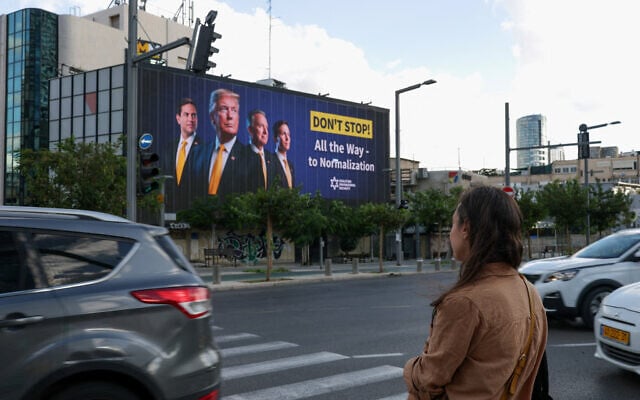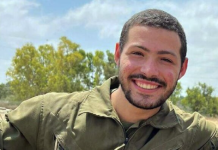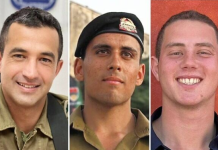- US special envoy confirms US pushing Israel to allow Hamas fighters holed up under Rafah to hand over their weapons in exchange for amnesty, calls it model for larger peace process
White House Mideast envoy Steve Witkoff claimed Thursday that Hamas officials told him and fellow Trump aide Jared Kushner that the terror group wanted to disarm during their “famous meeting” hours before the ceasefire was inked on October 9.
“Hamas has always indicated that they would disarm. They’ve said so — they said it to us directly during that famous meeting that Jared had with them,” Witkoff recalled, speaking to the America Business Forum conference in Miami.
“I hope that they keep their word because if they do, they’ll understand that the development plan that we have for Gaza is really terrific — a lot better than anyone has ever discussed before,” he continued, adding that it will include a “tremendous jobs program.”
Hamas officials have publicly taken a different stance, insisting either that the group will not disarm or have dodged the question entirely when pressed.
Privately, Arab diplomats familiar with the matter have told The Times of Israel that Hamas has indicated openness to give up their heavy weaponry, while holding on to lighter arms, in what likely would be a non-starter for Israel given that those same guns were used to mow down Israelis on October 7, while they have also been used to suppress internal dissent within the Strip.
Still, Witkoff told a conference in Miami that the US was “in the middle of standing up a decommissioning process [for] weapons — a demilitarization and amnesty program.
“Hamas has always said that we’re going to need the international security force to come in here and be the layer [that] they give the weapons to,” Witkoff said, adding that he hopes to muster that force in the next three weeks.
“That’ll be the inflection point where we see if everyone’s going to do as they say and demilitarize,” he said.
Witkoff’s comments came despite Hamas’s repeated expressions of opposition to the prospect of foreign troops entering Gaza.
US wants Israel to grant holed-up Hamas fighters safe passage
In his remarks, the US envoy also confirmed The Times of Israel’s reporting that Washington is leaning on Israel to grant safe passage to 100 to 200 Hamas operatives who are currently holed up in tunnels beneath the city of Rafah, in exchange for them giving up their weapons.
Witkoff said the initiative focused on those fighters who are located within an area that Israel controls in accordance with the ceasefire agreement, will serve as a “model” for the broader decommissioning and amnesty program.
“We may see the model of what we’re trying to do here… with these 200 fighters who are trapped in Rafah and whether they’re going to be able to raise their hands, walk out, turn over their weapons. This will be one of the tests,” Witkoff said, adding that he has been on the phone with Turkish Foreign Minister Hakan Fidan and Strategic Affairs Minister Ron Dermer.
Prime Minister Benjamin Netanyahu’s office has publicly pushed back against the idea of granting safe passage to the Hamas operatives, though a Middle East diplomat told The Times of Israel that Jerusalem has not ruled out the idea in private.
Still, Israel is arguing that at least some of the Hamas terrorists will have to be taken into Israeli custody at the very least, as they’re responsible for attacks on Israelis, the diplomat said.
Apparently recognizing the pressure from Washington, Defense Minister Israel Katz proposed exiling the Hamas fighters outside of Gaza, but received pushback from IDF Chief of Staff Eyal Zamir who said the terror operatives can either surrender or die.
For its part, the US fears that allowing Israel to kill all of those Hamas fighters would risk collapsing the fragile ceasefire in Gaza.
Witkoff said that if the US manages to “hold it together, then we’ll have even more credibility around the world. I’m very confident we will hold it together and we will complete the mission.”

The Trump administration’s 20-point peace plan, unveiled in late September, calls for Hamas to disarm and Gaza to be demilitarized, and for a temporary, technocratic government to be placed in charge of the Strip, which could eventually hand power to the Palestinian Authority.
Netanyahu backed the proposal when it was presented, but no agreement has been signed beyond the initial ceasefire deal, which secured the return of all living hostages and obligated Hamas to return the bodies of all dead hostages, in exchange for 250 Palestinian security prisoners serving life sentences and some 1,700 Palestinians detained in Gaza over the course of the war.
Ministers oppose ‘model’ Gazan city on Israeli side of Yellow Line
One of the main proposals for rebuilding the Gaza Strip that the Trump administration has presented to potential Gulf donor countries envisions the construction of roughly half a dozen residential regions on the eastern half of the Strip, which is currently under Israeli control, two Arab diplomats familiar with the matter told The Times of Israel last week.
Netanyahu appeared to present elements of the proposal during the cabinet meeting on Thursday night, explaining that the idea was to build a “model city” on the Israeli side of the Yellow Line.
Netanyahu said the goal of the city is to separate Hamas from the civilian population, who will be screened before being allowed to move into the newly constructed town, Ynet reported, relying on leaks from the cabinet meeting.
But several ministers pushed back on the idea, including Gila Gamliel, Orit Strock, Ze’ev Elkin and Miri Regev, claiming that it wouldn’t be safe for such a city to exist on the Israeli side of the Yellow Line, according to Ynet.
Netanyahu reportedly replied that the ISF would first be deployed in the Mawasi coastal area on the side of the Yellow Line that is de facto run by Hamas.
Arab diplomats have told The Times of Israel that the US is indeed looking to deploy the ISF on the Hamas side of the Yellow Line, but it’s unclear whether countries will be willing to contribute troops if the mandate of the force will be disarming Hamas through kinetic force.
BY: Times of Israel staff contributed to this report.







